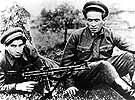
|
|
|

|

|

|

|
|
Click on an image to see a larger, more detailed picture.
|
|
|
|
|
| 1943: Death and Resistance |

|
pg. 472 |

|
|
|
|
| |
 Haika Grossman, a Jew, was an underground activist. As a youth she joined a Zionist youth movement in Bialystok, Poland, and she later helped organize underground resistance there following the German occupation. Grossman posed as a Polish gentile during her many missions to other ghettos on behalf of the Jewish underground. She also participated in the Bialystok Ghetto revolt in August 1943.This was one of the hundreds of mass graves dug near the Chelmno death camp. From 1941 to 1944, Chelmno gassed 150,000 to 320,000 people (estimates vary greatly), most of whom were Polish Jews. The Nazis stopped deportations to Chelmno in 1943 because the camp's gas-van extermination process was, in their minds, too slow. However, they reopened the camp in April 1944 to receive and kill the Jews of Lódz, Poland.
Haika Grossman, a Jew, was an underground activist. As a youth she joined a Zionist youth movement in Bialystok, Poland, and she later helped organize underground resistance there following the German occupation. Grossman posed as a Polish gentile during her many missions to other ghettos on behalf of the Jewish underground. She also participated in the Bialystok Ghetto revolt in August 1943.This was one of the hundreds of mass graves dug near the Chelmno death camp. From 1941 to 1944, Chelmno gassed 150,000 to 320,000 people (estimates vary greatly), most of whom were Polish Jews. The Nazis stopped deportations to Chelmno in 1943 because the camp's gas-van extermination process was, in their minds, too slow. However, they reopened the camp in April 1944 to receive and kill the Jews of Lódz, Poland.
Photo: Yad Vashem / United States Holocaust Memorial Museum Photo Archive
|
 The Katzowicz brothers fought in the Bialystok (Poland) Ghetto uprising of August 1943. The city had numerous underground factions, and not until 1943 did they put politics aside and unite in common purpose. During the five days of battle, more than 1500 Jewish fighters gave their lives.
The Katzowicz brothers fought in the Bialystok (Poland) Ghetto uprising of August 1943. The city had numerous underground factions, and not until 1943 did they put politics aside and unite in common purpose. During the five days of battle, more than 1500 Jewish fighters gave their lives.
Photo: Jack Lennard Archives / United States Holocaust Memorial Museum Photo Archive
|
 Bialystok
Bialystok
The northeastern Polish city of Bialystok was first occupied by the Germans on September 15, 1939. It was turned over to the Soviet Union, which held it for the next 21 months, and then reoccupied by the Germans on June 27, 1941. The creation of the ghetto in August 1941 sealed off Bialystok's 50,000 Jews. Because the ghetto needed workers for its factories and workshops, the Jews felt their lives would be spared. The Aktion of February 1943, however, quickly dispelled any thoughts of long-term security. Two thousand Jews were murdered in the streets of Bialystok, and 10,000 others were sent to their deaths at the Treblinka extermination camp. The liquidation orders of August 1943 spurred the ghetto's Resistance groups into action. The fighting lasted from August 16 to 20. With few arms at their disposal, the Resistance fighters were overwhelmed by the numerically superior and better-equipped German forces. Almost all of the fighters were killed by the Germans. Only a few hundred of Bialystok's Jews survived the war.
Photo: Yad Vashem
|
|

|

|

|

|
 August 16, 1943: Inmates revolt at the slave-labor camp at Krychów, Poland.
August 16, 1943: Inmates revolt at the slave-labor camp at Krychów, Poland.
|
 August 16-20, 1943: Nazi troops enter the Jewish ghetto at Bialystok, Poland, to destroy the more than 30,000 Jews inside. Hundreds of Resistance fighters, led by Mordechai Tenenbaum-Tamaroff and Daniel Moszkowicz--who battle back with small arms, axes, and bayonets--are annihilated. Those who survive are transported to death camps, where 25,000 are killed; See August 17, 1943.
August 16-20, 1943: Nazi troops enter the Jewish ghetto at Bialystok, Poland, to destroy the more than 30,000 Jews inside. Hundreds of Resistance fighters, led by Mordechai Tenenbaum-Tamaroff and Daniel Moszkowicz--who battle back with small arms, axes, and bayonets--are annihilated. Those who survive are transported to death camps, where 25,000 are killed; See August 17, 1943.
|
|
|
|
|
| 1943: Death and Resistance |

|
pg. 472 |

|
|
The Holocaust Chronicle
© 2009 Publications International, Ltd.
|
|
